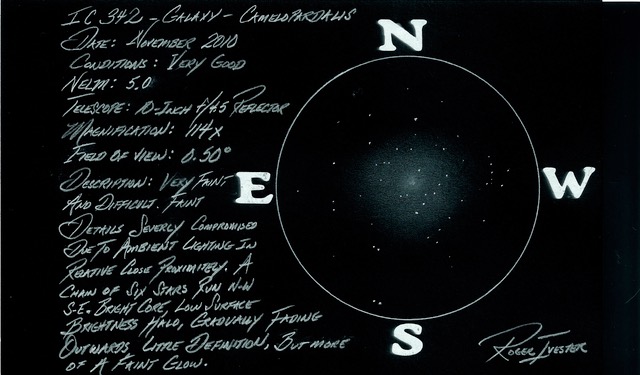Mario Motta: Observer from Massachusetts
This is a very difficult object visually, very faint surface brightness, due in-part to its large size and attenuation from outer spiral arms.The following image was made using my 32-inch f/6.5 telescope, with ASI 6200 camera. Total of 40 subs 5 minutes each,of Lum, R,G,B filters, and then 50 minutes of H alpha as well to bring out the surprisingly large number of H alpha regions you can see. Processing in Pixinsight, used especially modern processing techniques of Starnet 2, that allows “removing” foreground stars to enable processing the faint background, then adding the stars back in. (without this, nearly impossible to process properly).

Roger Ivester: Observer from North Carolina
IC 342, is a faint galaxy in Camelopardalis, and can be very difficult for the visual observer, due in-part to the low surface brightness and large size, requiring a dark sky with excellent transparency.
I made all observations with a 10-inch reflector from my moderately light-polluted suburban backyard. On a 5.0 NELM night, I located and observed this galaxy rather easily. A chain of six stars, with an orientation of NW-SE, lies a few minutes SW of the faint core.
This galaxy is best observed with low to medium magnification. I used 114x for the following pencil sketch. The 10-inch presented IC 342 as little more than a large faint glow without structure. A faint and small core could be seen with averted vision, with the absence of visible detail being attributed to the lack of a dark site, which reduced the contrast significantly.
On a night of lesser seeing and transparency, I was unable to see this galaxy with my 102mm refractor.

James Dire: Observer from Illinois
IC 342 is one of the most unique galaxies in the heavens due to its orientation, size and brightness. It’s a face-on spiral galaxy approximately 20 arc-minutes in diameter and glows at mag 9.67. Because of its size, brightness and orientation, it’s very hard to see visually. It spans only 1/3 the distance across as the face-on spiral M33 in the constellation Triangulum, which is 35 times brighter. So M33 is easier to see in a telescope.
IC 342 has about the same total luminosity as M100, a face-on spiral galaxy residing in Coma Berenices, however, since it spans three times the diameter as M100, but M100 is much easier to see visually.
The only face-on spiral galaxy with the same angular size that comes to mind is M101 in Ursa Major. However, M101 is 5 times brighter, so big light buckets reveal M101’s spiral arms with much greater ease.
IC 342 lies in the northerly constellation Camelopardalis. It is slightly southwest of the midpoint between two mag. 4.5 stars, Gamma Camelopardalis and BE Camelopardalis. The two stars are 5.75° apart.
To see IC 342 in its splendor requires a long exposure with an astronomical camera. The galaxy is classified as a weakly barred and loosely wound spiral galaxy.
The Hubble classification SABc. (S means spiral, AB means weekly barred, and c means loosely wound spiral arms). In barred spiral galaxies, the spiral arms usually originate at the ends of the bar. On IC 342, there appear to be two spiral arms originating from each end of the galactic bar. The arms tend to fan out as one traces them away from the bar. My image of IC 342 as following, was taken January 6, 2010 at the Wildwood Pines Observatory in Earl, NC.
I used an SBIG ST-2000XCM CCD camera, operating at -20°C, attached to a 190mm (7.5-inch) f/5.3 Maksutov-Newtonian telescope. The exposure was 60 minutes.

Sue French: Observer from New York
“Deep-Sky Wonders” P-15.
“….105mm scope at 28x, this pretty galaxy is a vaporous phantom spangled with faint stars. It appears oval, its long dimension running north and south with a 12′. From a dark-sky site with his 105mm refractor, noted observer Stephen O’Meara has been able to trace out IC 342’s three main spiral arms.”
The following pencil sketch was made using a 10-inch reflector at 88x.

Christian Luginbuhl and Brian Skiff: “Observing Handbook and Catalog of Deep-Sky Objects”
“….Large galaxy is relatively easy to see in small apertures at low powers. In 6 cm it is a faint blob north of a loose clustering of stars.”
“…25 cm a string of six stars runs SE-NW through where the object is seen in 6 cm.”







Recent Comments